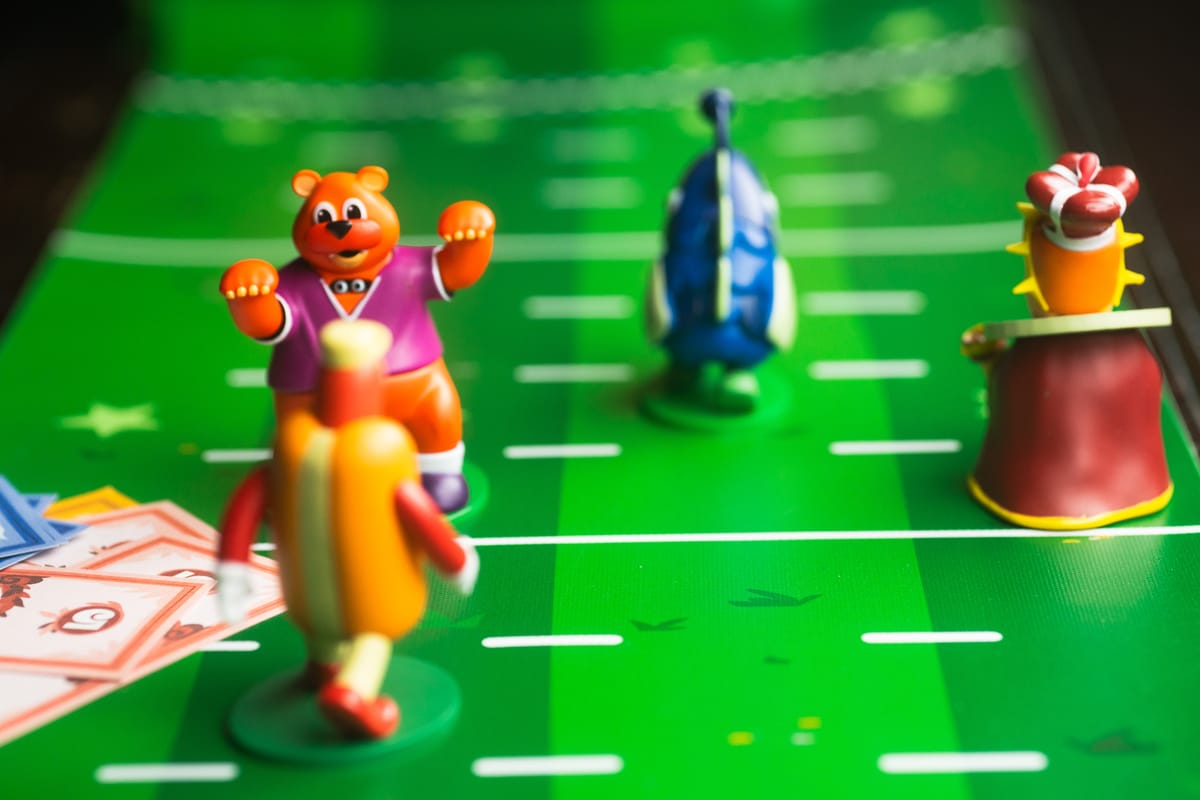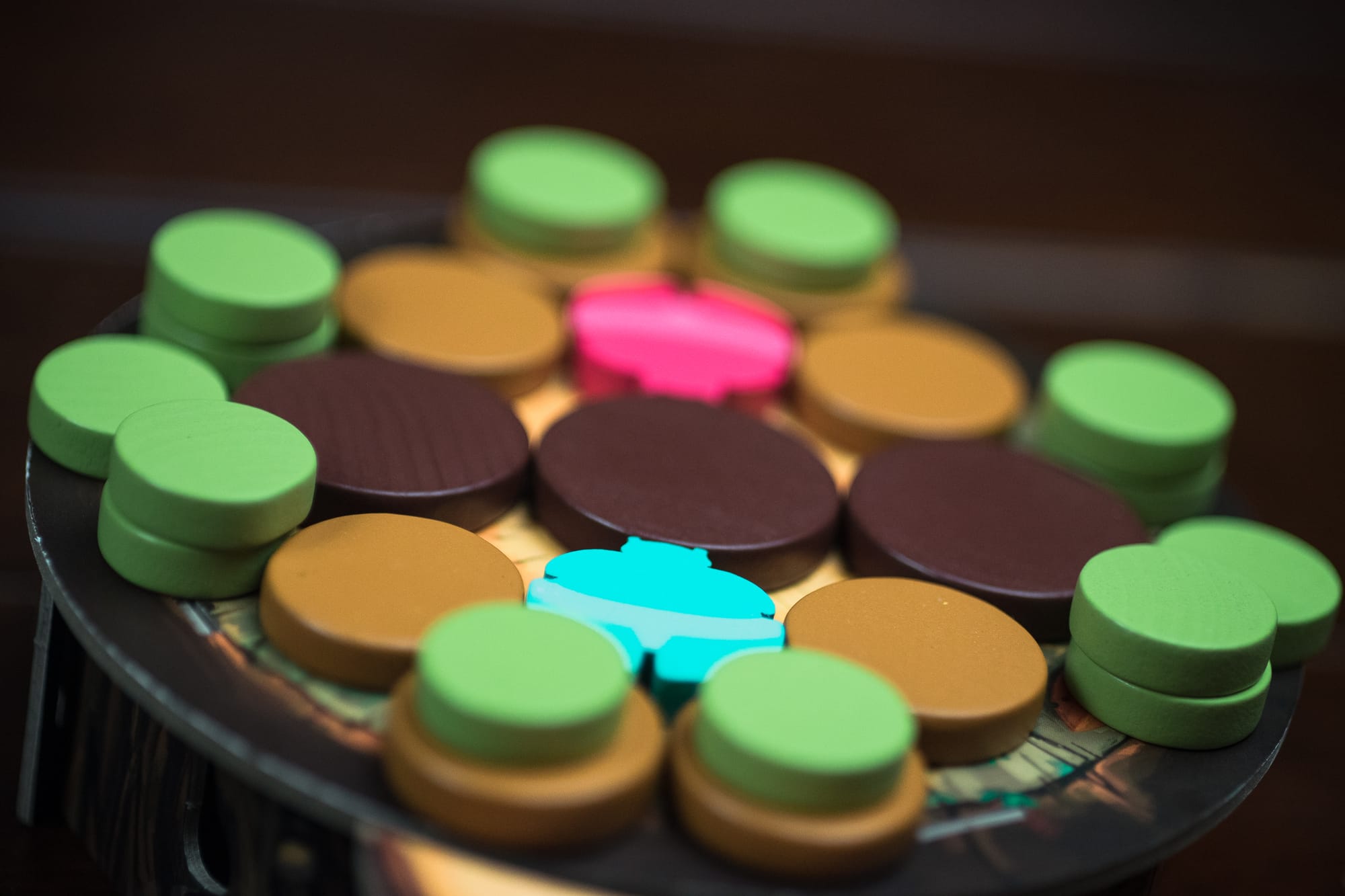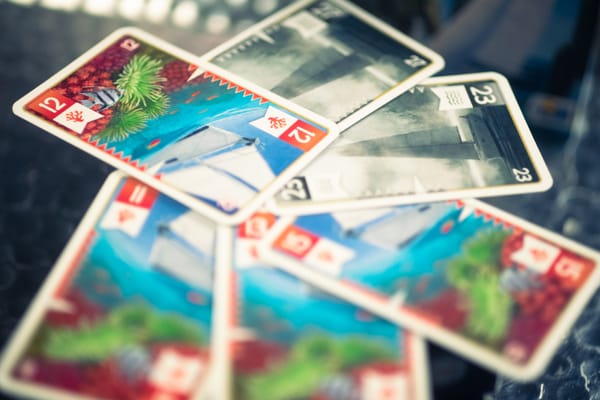Play more weird games
Seven great games that are just a bit weird.

A few months ago — four months, it turns out, which is quite a long time when you write every weak — I wrote about some great games that break convention. These are games that break convention, but in that act, they aren’t truly transgressive — they’re innovative. These aren’t games that you’d play once and set to the side. They aren’t experiments in design, though you might argue that Taiki Shinzawa’s Fives (2022) started as one, insofar as much of his catalog is an experiment. Nevertheless, that’s not an important tangent.
Today, I’m here to talk about games that are sometimes experimental. They do more than just break with convention; they set out to do something completely different. They might play with physical space in a way that's unusual in games. It might simply be that the idea’s just kind of, you know, out there.
None of these games are inaccessible. In fact, most of them should be pretty accessible for new players. That's an important thing for me this week: I want to talk about games that make me laugh, games that delight me — not games that twist my brain around. (I like those games, too. Don't get me wrong.) I might not be good at these weird games, but that doesn't much matter to me. These games make me want to come back time and time again as I try to catch one more glimpse of how an unexpected decision leads to joyful gaming.

Hot Streak (Perry, 2025) — Hot Streak isn’t that weird, right? I mean, the theme is a little weird, insofar as mascots are weird, and insofar as mascot races are even weirder, even if they’re a thing that exists. Yes, that’s weird, just maybe not truly weird. This is a game where you’re not playing as the racers. Again, not that weird. What’s weird about this game is that you have very little control over proceedings, but you’re still deeply invested in the proceedings of the race. That one card you contribute to the deck each round might seem like a small thing, but it has an outsized effect. Maybe that’s what makes it cool, but ultimately, I guess the weird part really is the guy in the hot dog suit falling over.
My two-year-old loves this game, too. He calls it the "king game," since one of the mascots is a king, of sorts. It's interesting that he doesn't call it the "hot dog game," though. (Also, he has no idea what he's doing when he plays with the pieces. This is not a child's game, but if CMYK decided to sell big, bendable mascot figures, I bet they'd sell like hotcakes.)
Designed by Jon Perry, illustrated by Cécile Gariépy, and published by CMYK.
The String Railway Collection (Hayashi, 2025) — I mean, you have a bunch of string, and you’re making a network with that string. This game has no business working at all. You basically have a collection of string that you’ll be placing on a flat surface of your choosing, and you’ll have some rules about what you can place, where you can place it, and how you interact with railway stations and other players’ pieces of string. This was first released in 2009, and the collection compiles expansions and additional content.
The game’s designer, Hisashi Hayashi, is one of the greats: Yokohama (2008) is a really well-regarded worker placement game, Bomb Busters (2024) is a limited-communication cooperative game I’d love to play, and Trains (2012) has long been seen as a great deck-building game. His roll-and-write Metro X (2018) is one of the crunchier in the genre I’ve played, while Rolling Japan (2014) is lighter roll-and-write fare. Trick of the Rails (2011) is a train trick-taker with a good weight to it, while Gummi Tricks is a fairly straightforward trick-taker. Hisashi Hayashi is one of the great names in game design, and this is probably the weirdest of his games I’ve played.

Kabuto Sumo (Miller, 2021) is a game that’s one-half professional wrestling tribute, one-half coin-pushing arcade game, and one-half a dexterity game with a little bit of strategy — that is, if you’re good enough to plan ahead. The weird part isn’t the theme (professional wrestling insects, though that’s still plenty weird), it’s that this is a take on those awful coin-pushing arcade games that always fool me into thinking that if I just put one more token in the slot, I’m going to get a load of tokens rushing down. See, that’s a concept that feels like it doesn’t lend itself to a competitive game. Those things are responsible for using so many of my tokens at nickel arcades. (A funny story, though. A local eatery has a genuine coin pusher filled with quarters. I once made $10 on that machine before promptly putting it all back in. I was picking up an order, and it just took a lot longer than expected. A good time.)
At any rate, Kabuto Sumo takes that idea, that coin-pusher mechanic, and it puts it into a system that doesn’t feel as high-risk. You’re not dropping pieces down a little chute — you’re doing the pushing, and you’re pushing these great wooden discs onto a raised board, and other pieces will fall off. You get those pieces, which you’ll later push on to the board. The whole goal is to push your opponent’s bug off the board while keeping yours in the ring. It’s weird, and I think it’s just really a smart take on a classically fun idea.
Designed by Tony Miller, illustrated by Kwanchai Moriya, and published by Allplay.
Hamster Roll (Zeimet, 2000) is a dexterity game where you’re playing wooden pieces on the inside of a wooden wheel. There’s no theme, and there’s doesn’t need to be: The wheel is huge — like 12 inches in diameter. It’s relatively thin, too. As you place pieces inside the wheel, it’s going to move. It is, after all, a wheel, and that’s why the wheel was invented. But when you’re trying to place things inside a wheel, it becomes a terrible inconvenience if it moves. This game is weird because it enacts a constraint on players that I just never would have expected. So often in dexterity games, the surface remains steady, but what you add will render structures unstable. The whole premise here is that you’re building on something that’s going to roll around and knock pieces off as you go. It’s a clever idea, and it combines into something at which I’m especially bad.
Designed by Jacques Zeimet, illustrated by Andrea Hofbeck and Stefan Sälzer, and published by Zoch Verlag.

The Fuzzies (Hague, Vickers and Warsch, 2021) is often described as Jenga (Scott, 1983) but with little pieces of fuzz, and that’s fundamentally true. You’re basically just grabbing one little fuzzball off a tower and placing it higher up on the tower. The tower is made entirely of these little fuzzy spheres. It’s a game that feels completely likely it has no business working, but you know what? It works. It works really well, even. This is a weird game from the inside out, and it delights in its weirdness. And, honestly, so do I.
Designed by Alex Hague, Justin Vickers and Wolfgang Warsch; illustrated by Adamantia Chatzivassileiou; and published by CMYK.
Make the Difference (Ono, 2022) — You know those puzzles you’d play as a kid, where you’d have to find the difference between two images? Well, this is a game where you get to be the person making those puzzles. I mean, sort of. This game’s weird because nobody would rightly expect to do that in a board game. That’s always somebody else’s job — something you don’t have to think about at all. Of course, you also want to fool your opponent, where a real puzzle designer wants to guide a player at an appropriate skill level. Anyway, weird game. I like it.
Designed by Shintaro Ono, illustrated by Jun Sasaki, and published by Oink Games.
Tearable Quest (Ono, 2025) is another game from Shintaro Ono, and it’s only other game from the designer to have seen Western publishing. I didn’t even realize these two games were both designed by the same person, but there’s no way I can’t include Tearable Quest, a game in which you tear a paper sheet into little pieces. You’ll be doing that on a timer, and you’ll be trying to tear in such a way as to capture certain symbols and avoid others. I am so not good at this game, but I love that it embraces weird design.
Designed by Shintara Ono, illustrated by Sai Beppu, and published by Allplay.
Hey, thank you for reading this week's edition of Don't Eat the Meeples! What weird games do you love? I know I've got a long list of games I could drop here, and someday, I'll probably follow this up. As for now, I'll leave it there. Have a great week, and I hope you get some great games in.





